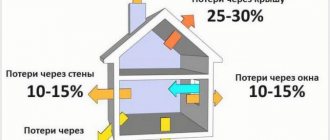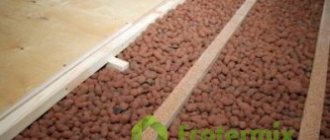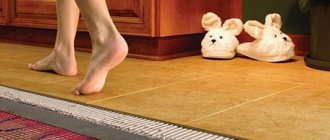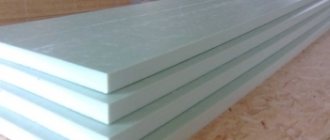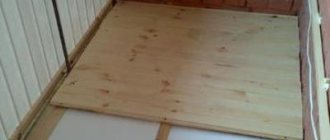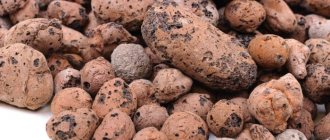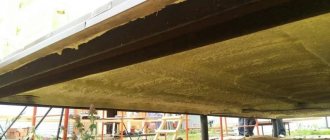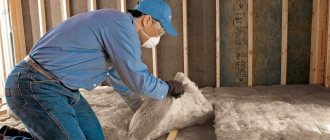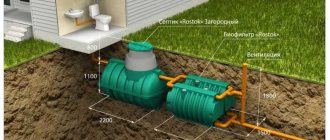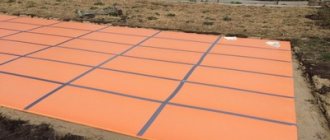Thermal insulation of floors in country houses, garages and any other one-story buildings is considered necessary. Indeed, according to various estimates, up to 20% of the heat accumulated in the house leaks through the floor. Insulating a floor is easier than insulating walls or ceilings. Especially if you use a material such as polystyrene foam, which has many advantages compared to other floor insulation materials. In addition, floor insulation with polystyrene foam can be done independently, without the involvement of skilled specialists.
The ratio of heat loss in the house
What is foam plastic
The name itself suggests the answer - it is a foamed plastic mass (polymer). It is created by the formation of granules filled with air and interlocked with each other. This technology creates a material that is more than 90% filled with air. This ensures its low thermal conductivity and unusually low weight. The starting materials for the production of this material can be various polymers. But traditionally polystyrene foam is called foamed polystyrene.
There are two ways to create expanded polystyrene.
- Conventional polystyrene foam is formed when the raw material mass is exposed to steam in a molding container. This is a well-known easily crumbling tile material, usually white.
Traditional expanded polystyrene foam
- Extruded polystyrene foam is made from pre-melted raw materials by pressing (extrusion) in special molding units. The resulting material has a denser structure, which provides greater strength and flexibility compared to conventional foam. But at the same time its weight increases.
Extruded polystyrene foam boards
Main article: floor insulation with sawdust.
What is penoplex
Penoplex, what is it? Penoplex is a modern material, it is based on polystyrene, which is foamed using technological processing, and unlike its “relative” foam, it consists of a homogeneous structure, and is also more dense and elastic.
This material is in high demand on the building materials market due to its excellent thermal insulation properties. Unlike polystyrene foam, it is more durable, and at the same time also waterproof. Thanks to these properties, it is used for thermal insulation work in any premises.
The structure of penoplex allows it to retain air, so it is always warm, this expands its scope of application in both heated and unheated buildings. Good results in the use of this material have been achieved when insulating the floors of balconies and loggias, as well as bathhouses and the lower floors of houses and apartments. Many experts advise installing penoplex when installing a “warm floor”.
Characteristics of penoplex:
The use of a heat insulator with certain characteristics depends on the place of application and purpose. When used to increase the thermal insulation properties of the floor, it is better to use penoplex with a greater thickness, and in some cases you can lay one layer of insulation on top of another.
Some cases show that layers of waterproofing can be glued together using special glue. Using these provisions will help create the most effective thermal insulation layer.
Very often, penoplex material is used in the construction of various objects; it is excellent for thermal insulation of floors installed directly on the ground or reinforced concrete slab, then the coating used as a floor is laid directly on it.
Some people use this product as an insulator in the construction of upper floors and various attics, which is not practical, since a material with lower thermal conductivity characteristics and, consequently, a lower price is quite suitable for these purposes.
The most appropriate use of penoplex is in the following cases:
- insulation of the loggia;
- thermal insulation of the balcony;
- installation of bath floor;
- insulation of various types of floors in a private house or cottage;
- installation of "warm floors".
How to insulate a floor with penoplex yourself. Use the following tips.
How to insulate a floor with penoplex?
Properties and characteristics of polystyrene foam as insulation
Thermal insulation of any buildings and structures requires a material with a low thermal conductivity. The weight of the insulation also matters. The table provides comparative data on these characteristics for foam plastic and other building materials.
| Material | Thermal conductivity, W/m*°С | Density, kg/m3 |
| Foam plastic of different brands | 0,038 – 0,043 | 15 — 50 |
| Extruded foam | 0,03 – 0,032 | 33 — 45 |
| Tree | 0,18 | 500 |
| Brick | 0,55 – 0,85 | 1500 |
| Expanded clay concrete | 0,58 | 1200 |
| Drywall | 0,21 | 800 |
| Mineral wool boards | 0,07 – 0,08 | 125 — 200 |
As you can see, the wood from which country houses are built is 4 to 5 times inferior to foam plastic in terms of insulation. And in terms of lightness, foam plastic surpasses almost all other heat-insulating materials.
But, before you get acquainted with how to insulate any floor with polystyrene foam, it is worth listing all its advantages and disadvantages.
Advantages of polystyrene foam
The positive qualities of this insulation are not limited to one or two properties. An extended list of its advantages is as follows:
- Low thermal conductivity allows the insulation to be laid in a relatively thin layer. This is critical for insulating some floors in low rooms.
- Light weight does not create a load on the surface.
- Waterproof. Does not allow moisture to pass through and retains its shape in a humid environment.
- Foam plastic retains its qualities in the temperature range from minus 50 to plus 95 ° C.
- Easy to process - can be cut with a regular knife. This is combined with ease of installation - you can easily cut slabs from it to any size.
- Does not require specialized installation skills. Anyone can lay an insulating layer of polystyrene foam with their own hands. This does not require any additional equipment or special clothing.
- Low price. For many this is the deciding factor.
- The material is “unattractive” to rodents and insects.
Disadvantages of polystyrene foam
- The main disadvantage is low fire safety. Expanded polystyrene not only burns in an open fire, but when burned it releases harmful substances that can cause suffocation. It is for this reason that it is recommended, whenever possible, to carry out thermal insulation with foam plastic on the outside of the insulated room.
- Poor vapor permeability. Because of this, moisture can settle on its surface, which can lead to mold or mildew.
- Weak mechanical strength. Ordinary polystyrene foam breaks when bent and crumbles when impacted. The extruded version is more stable in this regard.
Flaws
Among the disadvantages of floor insulation in a wooden house with Penoplex, one can highlight the fact that slabs of this material may contain a small amount of styrene, which in its free state is highly toxic. That is why it should be used in residential premises very carefully, covering it well with plasterboard sheets or cement screed.
Is polystyrene foam harmful to health?
This question still does not have a precise answer. On the one hand, one can come across claims that polystyrene foam releases many harmful substances that adversely affect numerous aspects of human health. On the other hand, over decades of using polystyrene foam in various fields, no cases of diseases associated specifically with the use of this material have been identified. And its use still continues even in the food industry.
It is reliably known that under the influence of sunlight or high temperature, an element harmful to health, styrene, is released from polystyrene foam. But under normal conditions, if styrene is released, its amount in the air does not exceed the maximum concentration regulated by sanitary standards.
However, for safety reasons, it is worth paying attention to the styrene content in the purchased polystyrene foam. In the best samples of imported materials, this value of harmfulness of the material does not exceed 0.05%. Unfortunately, in low-quality varieties of expanded polystyrene the styrene content reaches 0.2%.
If you want to use polystyrene foam, but health concerns are a concern, then be sure to insulate the floor with polystyrene foam only from the outside, and not from the inside of the living space.
Advantages of Penoplex
Thermal insulating material "Penoplex" has the following advantages:
- This insulation is made in the form of panels. They are easy to cut and install on the selected surface.
- "Penoplex" is a foam material that has excellent thermal insulation properties due to air layers. Thermal qualities are 25 times better than expanded clay concrete.
- The structure is dense and does not allow cold air flows to pass through.
- In the summer season, the material protects against heat penetration into the house.
- Thanks to the versatility of the material, it is possible to create a year-round favorable microclimate in the room.
- “Penoplex” is not subject to wear and tear and lasts for a long time.
- The material is resistant to moisture, which allows the insulation process to be carried out without the use of a waterproofing film or membrane. Laying is done on the subfloor. It is even used in places with high groundwater levels.
- The material has an affordable price.
- The material is able to withstand heavy loads without losing its functional characteristics. On average it can withstand up to 400 kg.
- "Penoplex" is used together with heated floors and acts as a substrate, waterproofing and heat insulator.
- When heated, the material does not release toxic substances. But at high temperatures it becomes deformed and loses quality.
- The material is susceptible to damage by rodents.
Advice! When choosing Penoplex for floor insulation, it is recommended to pay attention to sheets with profiled edges. They will prevent cold air from passing between the panels.
Tools for processing polystyrene foam
Although it is obvious that polystyrene foam is an easy-to-process material, you can find references to special thermal cutters or even machines for cutting this material. But they are rather required for those who constantly work with this material or are engaged in figure cutting. For a one-time use, it is hardly advisable to purchase an expensive device, and shaped cutting for an insulated floor is not required.
When cutting foam plastic for floor insulation, the following tools may be required:
- An ordinary knife. A sharp knife with a long blade is capable of cutting any type of polystyrene foam. Even a kitchen knife with a serrated edge will work for thin slabs.
- Hacksaw. Some may find it more convenient to cut the material with a hacksaw. Please note that a hacksaw with fine teeth is better suited for cutting foam. A larger tooth will produce a more chipped edge.
- String. For this purpose, you can use old guitar strings attached to two handles. They cut with such a device as a two-handed saw.
Of course, these tools are not able to provide a smooth edge at the cut points. But for joining foam plastic floor slabs, a perfectly straight edge is not needed.
Helpful advice. When cutting foam with any of these tools, it is recommended to provide a liquid lubricant on the cutting surface. This will make it easier to work with the tool and reduce the unpleasant sound that accompanies cutting.
Penoplex floor insulation technology
Any process associated with construction or renovation consists of several stages, and the sequence of their implementation is mandatory. So, let's look at it in order:
Preparation
- Before insulating the floor, ensure thermal insulation of the remaining surfaces, since without this condition there is no point in insulating the floor.
- If necessary, insulate the basement of the house, for which you can also use Penoplex.
Base insulation
Warming stage
If the floor insulation is planned to be done on the ground floor and there is access to it through the basement, then the insulation technology is as follows:
- The surface on which the insulation is attached must be cleaned of debris, mold or mildew.
- Apply a primer that will protect the ceiling from the appearance of mold and mildew.
- Having prepared the surface, proceed to attaching the insulation. This material can be attached in two ways:
- The first method involves fastening the panels directly to the floor surface using dowels with umbrella tips.
Fastening Penoplex with dowels
- The second method involves fastening the sheets into a specially prepared sheathing, consisting of joists and cross bars for strength.
Having laid the insulation between the joists, the frame is sheathed with plasterboard or plywood, which is treated with dyes.
Frame insulation of floors
Features of foam insulation of various floors
Strictly speaking, “insulation” is not quite the correct term. Polystyrene foam, like any other material, does not provide any insulation, but simply provides high-quality thermal insulation. But it just so happens that when talking about thermal insulation, the word “insulation” is used with the same meaning.
Floors to be laid differ both in the material of manufacture (wood, concrete) and in the conditions of their location and operation. Each of these types of floors has its own characteristics of thermal insulation and recommendations for its installation. Understanding how to properly create foam insulation for a specific type of floor will help you avoid mistakes.
The main problem for the foam plastic insulation layer is the violation of thermal insulation at the joints of the sheets. Often, to securely join two sheets of foam, chamfers are removed along the edges. But now on sale there are sheets of expanded polystyrene with ready-made chamfers along the edges.
Expanded polystyrene sheets with chamfers
But foam plastic sheets are also produced that are joined to each other using the “tongue and groove” principle. This technology provides a virtually indestructible insulating layer.
Plates joined using tongue and groove technology
Floor with an unheated basement underneath
If it is possible to install thermal insulation on the basement side, then you should definitely take advantage of it. Of course, insulating the floor from the bottom of the ceiling is difficult and tedious, not to mention the fact that work in the basement is often carried out in cramped conditions and darkness. But insulation from the side of the cold source, which is the basement, is considered correct according to the laws of heating engineering. And such thermal insulation works effectively and for a long time.
The technology for laying insulation is simple: the basement ceiling is covered with sheets of foam plastic. Methods for attaching sheets to the ceiling:
- On glue. You can use regular glue, for example PVA. But it is better to purchase specialized glue for polystyrene foam. Do not use adhesives containing acetone. They will corrode this insulation.
- Fastening with special “umbrella” dowels with a wide head.
Dowel “umbrella” for additional reinforcement of foam
- Combined fastener. Sheets of foam plastic are glued to the ceiling, and then nailed with several dowels for greater reliability.
Insulation of the floor from below - basement ceiling covered with sheets of foam plastic
Thermal insulation of the floor along the joists
This is the simplest and most cost-effective method of foam thermal insulation. Its advantage is that the load of the finished floor falls on the logs. Therefore, the strength characteristics of the foam layer do not matter.
- A waterproofing film is spread on the prepared and cleared of debris base.
- Wooden logs are laid
- Foam sheets are laid between the joists
- The joints between the sheets and in places adjacent to the joists can be filled with polyurethane foam.
- A vapor barrier layer is laid on top of the insulation.
- The finished floor is installed along the joists
Floor insulation with foam plastic under concrete screed
This design, in which the insulation is located under a layer of concrete, is sometimes called a warm screed.
Warm screed installation diagram
In this case, the foam layer bears the entire load of the floor, so measures must be taken to reduce it. Significant level changes will lead to destruction of the foam sheet.
- The preparation of the base must be carried out carefully. All irregularities (pits, crevices and cracks) that could lead to damage to the insulating layer are sealed.
- A layer of waterproofing is laid. The waterproofing film is laid overlapping with an overlap of 5 - 10 cm and overlapping the walls at the same distance. The joints are insulated with tape.
- The next stage is laying foam boards. To securely fix them, it is useful to apply glue or foam along the edges of each plate.
- If the insulation sheets do not have chamfers or grooves with tenons, then the joints are filled with polyurethane foam.
- A polyethylene film is spread over the laid insulation. Its task is to prevent the penetration of moisture when pouring a concrete screed.
- To evenly distribute the load on the foam, laying a metal grid is required.
View of an insulated floor before pouring a concrete screed
- At the final stage, the concrete screed itself is poured.
Pouring a warm screed with concrete mortar
Is it possible to insulate wooden floors with polystyrene foam?
Some experts do not recommend thermal insulation with foam plastic laid on a wooden base. For wooden load-bearing structures, reliable ventilation is important to prevent the formation of dampness. Polystyrene foam is an airtight material, and when laying it on a wooden base, it is possible that there will be a complete lack of air flow to the tree. This is fraught with the fact that sooner or later moisture will accumulate under the foam layer, which will destroy the wooden elements of the floor.
But the wooden floor, which is supposed to be laid on the ground, can be insulated with foam plastic.
Ground insulation scheme
The installation process is as follows:
- The soil is firmly compacted
- A cushion of sand and crushed stone is laid on the ground
- A layer of waterproofing is spread
- Expanded polystyrene sheets are laid. For soil laying, it is advisable to choose a material of increased density - at least 35 kg/m3. For lower-density foam, it is worth laying it in two layers, with the seams moving between the sheets.
- Before laying the finished floor, the entire insulating layer is covered with a vapor barrier film.
Insulation of wooden floors along logs
Insulating a wooden floor with polystyrene foam is a significant task when carrying out renovations in a house, cottage or ordinary house. Today, wooden floors are no less popular than in the old days, as they place a small load on the slab, regardless of the height.
Wood flooring is a combination of air space between the floor and boards, and a layer of wood.
Therefore, to insulate the floor along the joists using polystyrene foam, you will need to perform a whole sequence of work. But there is nothing complicated here, since anyone can do it without calling a specialist, because wood is the simplest and most convenient means of compaction.
So, to insulate the floor in a wooden house, you need to adhere to the following technology:
- first clean the surface, repair all cracks and smooth out any irregularities;
- then lay a 10 cm thick foam layer on the floor on top. Then apply a waterproofing film on top. Choose only high-quality film, since even the slightest contact with moisture on the thermal insulation material will significantly reduce its quality.
- After this, you will need to make a special wooden sheathing - a log, where the thermal insulation material will be placed. With this floor design, the load will be evenly distributed on the frame.
- Install polystyrene foam onto the film, placing the sheets tightly pressed against each other. After this, be sure to seal all joints and cracks with foam.
- Apply one more layer of film on top, as this will serve as good protection against liquid getting on the foam layer.

